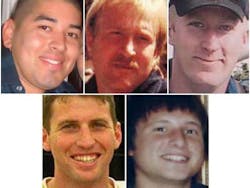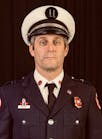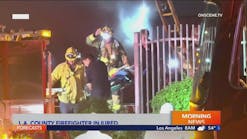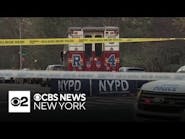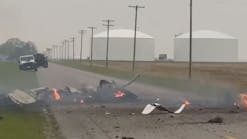The Human Element: Revisiting the Lessons of the Esperanza Fire
Editor’s note: Discuss wildland firefighting and NFFF’s New Goals initiative to reduce firefighter line-of-duty deaths to under 50 annually in the following Firehouse.com Forums:
- During wildland fires, do you think the public expects firefighters to take greater risk to protect houses than other types of property? Does this affect fire operations?
- Is survivability profiling a regular part of your size-up on structural fires? Why or why not?
And find more information on the NFFF’s New Goals initiative at www.everyonegoeshome.com/new-goals.
A couple months ago, as I made one of my many visits to San Diego to prepare for Firehouse World 2016, I had the unique opportunity to visit the site of the Esperanza Fire, a wind-driven wildland/urban interface (WUI) fire that occurred in 2006. Tragically, five firefighters from U.S. Forest Service Engine (USFS) 57 were killed defending a vacant house during the fire.
Today, a memorial and a staff ride have been established at the site of the fire. (Staff rides date back to the 1800s, when military leaders began taking soldiers on tours of places where significant battles or military actions were likely to occur. Later, the staff ride evolved to involve visiting places where battles or campaigns had occurred, and it has since become a key training tool in the military and now public safety.)
What I experienced there was moving, to say the least. But it was also eye-opening. The lessons of the Esperanza Fire have a direct application to structural firefighting—and not only because, as the WUI expands, the lines between “wildland firefighter” and “structural firefighter” are beginning to blur. This event holds key insights into the complex, yet directly relevant topic of human factors and how reducing line-of-duty deaths (LODDs) in the fire service depends in large part on learning to manage the decision-making and related human factors that contribute to tragedy.
The Esperanza Fire
The Esperanza Fire started on Oct. 26, 2006, in Cabazon, Calif., about two hours north of San Diego. Driven by Santa Ana winds, it burned 41,000 acres and destroyed 34 homes. An investigation later determined that the fire was set by an arsonist, and in 2009 Raymond Lee Oyler was sentenced to death for the crime.
USFS Engine 57 was one of several engines called in to help defend the Twin Pines community, about 30 houses on a steep ridge. They positioned near a house known as The Octagon on account of its unique shape. A shift in winds caused the fire to race rapidly up the ridge and burn over the house, which was ultimately destroyed. The five firefighters were caught in the burnover; three died at the scene while the other two died at the hospital.
As with any firefighter fatality, numerous factors contributed to this tragedy. But in summing them up, the USFS Accident Investigation Factual Report minced no words: “The human elements are critical factors in the evaluation of this investigation. A risky decision or a series of risky decisions appear to have contributed to this dangerous situation from which there was no room for error.”
An entire science is built around the study of human factors analysis, and I am by no means going to do the subject justice in a brief article. But I believe that the study of human error holds the key not only for reducing wildland fire deaths, but reducing deaths and injuries on structural firegrounds as well. So let’s focus on just two human factors-related lessons from the Esperanza Fire.
Triage
Following the fire, the California Wildland Fire Working Group established nine WUI operating principles that touch on risk assessment and management. These principles were hardly ground-breaking; they largely repeated what could already be found in various wildland fire training materials—with one key difference. Explaining the principles to staff, Regional Forester Randy Moore and Associate Deputy Chief James Peña emphasized: “Rather than seek ways to protect every structure, each structure and location must first prove that protection can be provided safely and with the assurance of success” (emphasis added).
In effect, these leaders were summing up the evolution from structure protection to structure triage. The concept of triage has guided mass-casualty medical care for decades. But it applies in structural and wildland firefighting as well. We need to be able to identify those things that are lost regardless of any action we might take. And then we need to have the courage to make the decision not to commit resources to try to save them.
That can be a gut-wrenching decision at a structure fire, when you may be faced with the pleas of family members who know their loved one is inside. It’s also difficult for wildland firefighters when citizens implore them to save their homes. But it is a necessary decision. We can no longer accept firefighters taking risks based on false hopes. The decision to engage in structure protection or interior fire operations needs to be based on available facts, not emotion. And in structure fires, we must employ controlled aggressiveness based on victim viability, directing search efforts to tenable spaces for viable victims.
How do you train firefighters to triage based on survivability? That’s a key question for any instructor, and a discussion that will engage the fire service for some time to come. At the very least, however, it starts with acknowledging that firefighters must be willing to do so.
Risk Toleration
A second human factors lesson from the Esperanza Fire comes from the USFS Accident Investigation Factual Report, which lists both casual and contributing factors. One contributing factor stands out:
"Contributing Factor 1. Organizational culture - The public (social and political) and firefighting communities expect and tolerate firefighters accepting a notably higher risk for structure protection on wildland fires, than when other resources/values are threatened by wildfire."
This is another painful lesson, and another that has a direct corollary in structural firefighting. We, as a firefighting community, are complicit in these deaths because we tolerate the risk. Time and time again we hear anguished family members of firefighters lost in the line of duty argue that no life is worth an empty structure. We nod and pledge never to forget—but do we really absorb the lesson? Do we change our tactics so that, when faced with structural fire conditions under which survivability is impossible, we do the brave (and logical) thing and adjust our operations to take less risk? Or do we allow the adrenaline, the pressure of the fire and of our peers to lead us to tolerate a risk not worth taking?
Again, risk toleration is not something that we will easily change. But just acknowledging that firefighters face cultural pressures that can lead to tolerating unacceptable risks is a starting point. We cannot change our behavior until we understand what leads us to act in certain ways.
Better Decisions
The National Fallen Firefighters Foundation’s New Goals campaign is an attempt to reduce annual LODDs to under 50. Once we have focused on and eliminated the “low-hanging fruit”—causes of LODDs that have obvious solutions, such as not being fit for duty—our task becomes much more difficult. It involves understanding the human element of firefighting—what leads us to make the decisions we do, and how, with better awareness of contributing and casual factors, we can ultimately become better decision-makers. The Esperanza Fire is an important starting point for that discussion.
This article is in memory of Jason McKay, Jess McLean, Daniel Najera, Mark Loutzenhiser and Pablo Cerda, who gave their lives fighting the Esperanza Fire.
TIMOTHY E. SENDELBACH is the Editor-in-Chief for Firehouse. A 29-year student and educator of the fire and emergency services, he is responsible for the content and editorial direction of Firehouse® Magazine, Firehouse.com, Firehouse Expo, Firehouse World and related products. He has served as an assistant fire chief with the North Las Vegas, NV, Fire Department, as the chief of training for Savannah, GA, Fire & Emergency Services and as assistant fire chief for Missouri City, TX, Fire & Rescue Services. He is a credentialed Chief Fire Officer and Chief Training Officer and has earned a master’s degree in leadership from Bellevue University, bachelor’s degrees in fire administration and arson and an associate’s degree in emergency medical care from Eastern Kentucky University. You can e-mail him at [email protected].
